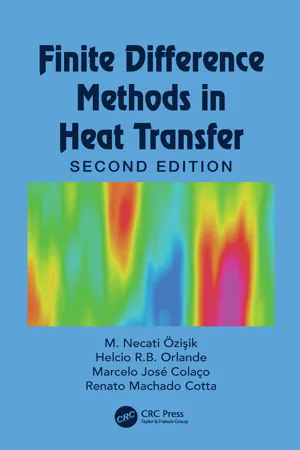
eBook - ePub
Finite Difference Methods in Heat Transfer
M. Necati Özişik, Helcio R. B. Orlande, Marcelo J. Colaço, Renato M. Cotta
This is a test
Compartir libro
- 580 páginas
- English
- ePUB (apto para móviles)
- Disponible en iOS y Android
eBook - ePub
Finite Difference Methods in Heat Transfer
M. Necati Özişik, Helcio R. B. Orlande, Marcelo J. Colaço, Renato M. Cotta
Detalles del libro
Vista previa del libro
Índice
Citas
Información del libro
Finite Difference Methods in Heat Transfer, Second Edition focuses on finite difference methods and their application to the solution of heat transfer problems. Such methods are based on the discretization of governing equations, initial and boundary conditions, which then replace a continuous partial differential problem by a system of algebraic equations. Finite difference methods are a versatile tool for scientists and for engineers. This updated book serves university students taking graduate-level coursework in heat transfer, as well as being an important reference for researchers and engineering.
Features
- Provides a self-contained approach in finite difference methods for students and professionals
- Covers the use of finite difference methods in convective, conductive, and radiative heat transfer
- Presents numerical solution techniques to elliptic, parabolic, and hyperbolic problems
- Includes hybrid analytical–numerical approaches
Preguntas frecuentes
¿Cómo cancelo mi suscripción?
¿Cómo descargo los libros?
Por el momento, todos nuestros libros ePub adaptables a dispositivos móviles se pueden descargar a través de la aplicación. La mayor parte de nuestros PDF también se puede descargar y ya estamos trabajando para que el resto también sea descargable. Obtén más información aquí.
¿En qué se diferencian los planes de precios?
Ambos planes te permiten acceder por completo a la biblioteca y a todas las funciones de Perlego. Las únicas diferencias son el precio y el período de suscripción: con el plan anual ahorrarás en torno a un 30 % en comparación con 12 meses de un plan mensual.
¿Qué es Perlego?
Somos un servicio de suscripción de libros de texto en línea que te permite acceder a toda una biblioteca en línea por menos de lo que cuesta un libro al mes. Con más de un millón de libros sobre más de 1000 categorías, ¡tenemos todo lo que necesitas! Obtén más información aquí.
¿Perlego ofrece la función de texto a voz?
Busca el símbolo de lectura en voz alta en tu próximo libro para ver si puedes escucharlo. La herramienta de lectura en voz alta lee el texto en voz alta por ti, resaltando el texto a medida que se lee. Puedes pausarla, acelerarla y ralentizarla. Obtén más información aquí.
¿Es Finite Difference Methods in Heat Transfer un PDF/ePUB en línea?
Sí, puedes acceder a Finite Difference Methods in Heat Transfer de M. Necati Özişik, Helcio R. B. Orlande, Marcelo J. Colaço, Renato M. Cotta en formato PDF o ePUB, así como a otros libros populares de Sciences physiques y Énergie. Tenemos más de un millón de libros disponibles en nuestro catálogo para que explores.
Información
1
Basic Relations
Numerical methods are useful for solving fluid dynamics, heat and mass transfer problems, and other partial differential equations of mathematical physics when such problems cannot be handled by exact analysis techniques because of nonlinearities, complex geometries, and complicated boundary conditions. The development of high-speed digital computers significantly enhanced the use of numerical methods in various branches of science and engineering. Many complicated problems can now be solved at a very little cost and in a very short time with the available computing power.
Presently, the finite difference method (FDM), the finite volume method (FVM), and the finite-element method (FEM) are widely used for the solution of partial differential equations of heat, mass, and momentum transfer. Extensive amounts of literature exist on the application of these methods for the solution of such problems. Each method has its advantages depending on the nature of the physical problem to be solved, but there is no best method for all problems. For instance, the dimension of the problem is an important factor that deserves some consideration because an efficient method for one-dimensional problems may not be so efficient for two- or three-dimensional problems. FDMs are simple to formulate and can readily be extended to two- or three-dimensional problems. Furthermore, FDM is very easy to learn and apply for the solution of partial differential equations encountered in the modeling of engineering problems for simple geometries. For problems involving irregular geometries in the solution domain, the FEM is known for having more flexibility because the region near the boundary can readily be divided into subregions. A major drawback of FDM used to be its difficulty to handle effectively the solution of problems over arbitrarily-shaped complex geometries because of interpolation between the boundaries and the interior points, in order to develop finite difference expressions for nodes next to the boundaries. More recently, with the advent of numerical grid generation approaches, the FDM has become comparable to FEM in dealing with irregular geometries, while still maintaining the simplicity of the standard FDM.
In this book, we ...